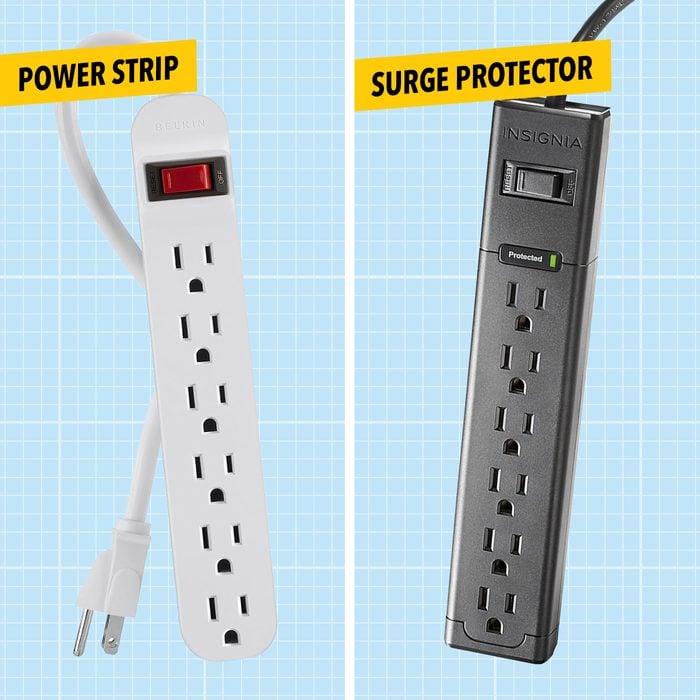What’s the Difference Between a Surge Protector and a Power Strip?
Updated: Mar. 07, 2024

Surge protectors and power strips look alike, but they have different functions. Here's how to tell what's what.
Our editors and experts handpick every product we feature. We may earn a commission from your purchases.
Wherever you work or play, you probably have lots of experience with power strips and surge protectors. If you’re anything like me, you have a television, computer, phone charger and Xbox all plugged in to a strip hidden in a cabinet or under your desk.
Extending power from wall receptacles is convenient and necessary, especially in older homes that may not have modern wall receptacle layouts — which, according to the National Electric Code, is every 12 feet in a typical living room.
But what’s the difference between a surge protector and a power strip? Have you ever looked at yours? It’s important not to interchange them, especially when plugging in your sensitive electronics.
Even though they look similar, they have different functions. Here’s what to know.
On This Page
What Is a Power Strip?
Think of a power strip as an extension cord with receptacles (colloquially: “outlets”) on the end.
When you need more places to plug in simple, low-amp devices like lamps, alarm clocks and fans, power strips bring electricity from your wall receptacle to a convenient strip that can handle multiple devices (within reason). Power strips may also have a switch to turn everything on the strip on and off at once.
Basic power strips can be found for less than $10.
What Is a Surge Protector?
Surge protectors take the basic premise of power strips and add an important safety feature: protection from sudden electrical surges that can harm your electronics and other sensitive devices.
Power surges are sudden, brief, higher-than-normal voltage spikes. They can come from lightning strikes, fluctuations on the grid from the utility, large appliances starting up, and even static electricity. This extra protection bumps up the price a bit, from $20 for a basic model to about $50 for more functionality and ports.
One thing to note: Surge protectors come in different forms, from the kind I bought for my computer (called “Type 3”) to ones that mount inside your electrical panel to protect your entire house. Here, we’ll limit the discussion to power strip-style devices.
Surge Protector vs. Power Strip: How to Tell
Surge protectors resemble power strips, in that they’re extensions of the wall receptacle and come with an on/off switch for ease. But it’s important to know how to spot their differences, because a simple power strip won’t protect expensive computers, entertainment centers and gaming systems.
When buying new, pay attention to the labeling to make sure you’re buying the right thing. This information should be visible on the packaging and in the online description. For the ones you already have at home, some of this info may be right on the strip itself, even if you’ve long since thrown away the packaging.
- Listing mark: Listing means that the manufacturer conforms to rigorous safety specifications from a certification organization, like UL or Intertek. Look for a sticker or other mark with the words “surge protection device” under the listing designation. Listed power strips will have the listing mark but won’t say “surge protection.” Never buy an unlisted surge protector or power strip.
- Indicator light: Some surge protectors have a light that lets you know if the protection is still good. If yours has a light and it’s not on, that means the mechanism that dissipates the surges has been depleted, and it’s time to buy a new one. (It will likely still function as a power strip.)
- Joule rating: Joules are units of energy. When printed on a surge protector, it will indicate how much energy can be dissipated before failure.
- Voltage protection rating (VPR): This number describes how many volts the surge protector allows through to your electrical devices during a surge event. These start at 330 volts and go up. Lower numbers are better.
- Nominal discharge current (In): If you have a surge protector, it may have a number on the back in kiloamperes (kA) — generally 3kA for home use — that indicates the level of protection that remains after a set number of uses.
When Is a Surge Protector the Best Choice?
Use a surge protector for electronics that would cost a lot to replace, or where you could lose important data if a voltage surge occurred: desktop computers, televisions, gaming systems, laptops and phone chargers.
There’s nothing wrong with using a surge protector instead of a power strip for inexpensive items, too. But keep in mind surge protectors cost more than regular power strips.
When Is a Power Strip the Best Choice?
Power strips work great when you need more receptacles than you have on the wall. Maybe you have multiple Christmas light strings or a reading lamp that doesn’t reach the wall receptacle.
It’s important not to overload them, though. Power strips and surge protectors don’t add any circuit capacity to your home — they simply extend the circuit already there. Never use either one to plug in multiple high-amp appliances like microwaves or air fryers.
